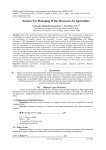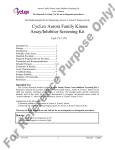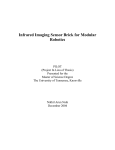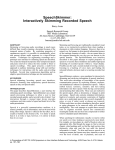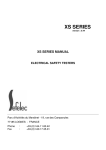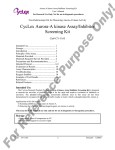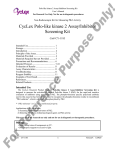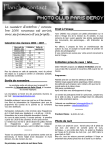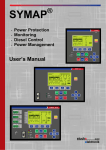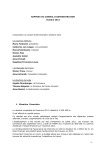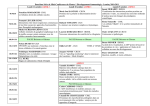Download CY-1179
Transcript
On ly! Human Mps1/TTK kinase Assay/Inhibitor Screening Kit User’s Manual For Research Use Only, Not for use in diagnostic procedures Non-Radioisotopic Kit for Measuring Human Mps1/TTK Activity CycLex Human Mps1/TTK kinase Assay/Inhibitor Screening Kit Pu rp Intended Use................................................ 1 Storage......................................................... 1 Introduction.................................................. 2 Principle of the Assay.................................. 3 Materials Provided....................................... 4 Materials Required but not Provided........... 4 Precautions and Recommendations............. 5 Detailed Protocol......................................... 6-9 Evaluation of Results................................... 10 Assay Characteristics................................... 10 Troubleshooting........................................... 10 Reagent Stability.......................................... 10 Example of Test Results.............................. 11-12 References.................................................... 13 Related Products.......................................... 14 os e Cat# CY-1179 ce Intended Use en The CycLex Research Product CycLex Human Mps1/TTK kinase Assay/Inhibitor Screening Kit is designed to measure the activities of purified human Mps1/TTK for the rapid and sensitive evaluation of inhibitors or activators. The phospho-serine specific monoclonal antibody used in this assay kit has been demonstrated to recognize the phospho-serine residue in recombinant human Mps1-substrate, which is phosphorylated by human Mps1/TTK. er Applications of this kit include: 1) Screening inhibitors or activators of human Mps1/TTK. 2) Detecting the effects of pharmacological agents on human Mps1/TTK activity. This assay kit is for research use only and not for use in diagnostic or therapeutic procedures. Storage rR ef • Upon receipt store all components at 4°C. • Don’t expose reagents to excessive light. Fo Cat#: CY-1179 1 Version#: 140318 On ly! Human Mps1/TTK kinase Assay/Inhibitor Screening Kit User’s Manual For Research Use Only, Not for use in diagnostic procedures Introduction Pu rp os e Recently, the vertebrate orthologues of the yeast MPS1 kinase were identified and found to localize to kinetochores (1.2). MPS1 encodes a tyrosine and serine/threonine dual-specificity kinase (3) that was originally identified in a genetic screen for mutants defective in spindle pole duplication (4). Subsequently, it was discovered to be an essential component of the mitotic checkpoint (5). Consistent with yeast MPS1, mouse Mps1 is localized at centrosomes throughout the cell cycle and is essential for accurate centrosome duplication (6). However, a recent study indicated that human Mps1 was not localized at centrosomes in human U2OS cells (1). Despite the discrepancy in the centrosome localization of Mps1 in mouse and human cells, it is clear that Mps1 is present at kinetochores during mitosis, where it may participate in the checkpoint. The human Mps1/TTK kinase was originally identified in a screen for novel tyrosine kinases by using a phosphotyrosine antibody to screen a T-cell cDNA expression library (7). Using a similar strategy, the mouse homologue, esk, was also cloned from an embryonal carcinoma cell line (8). It was determined subsequently that esk was the mouse orthologue of yeast MPS1 (6). Human Mps1 is detectable in all proliferating human cells and tissues. Expression of the human Mps1 gene is markedly reduced or absent in resting cells and in tissues with a low proliferative index. Levels of human Mps1 mRNA and protein are very low in starved cells. When cells are induced to enter the cell cycle, levels of human Mps1 mRNA, protein and kinase activity increase at the G1/S phase of the cell cycle and peak in G2/M. Human Mps1 mRNA levels, as well as kinase activity, drop sharply in early G1, whereas protein levels are largely maintained. Human Mps1 may play a role in cell cycle control. Measurement of Human Mps1/TTK activity rR ef er en ce The protocol generally regarded as most sensitive for the quantitative measurement of human Mps1/TTK activity involves incubation of the human Mps1/TTK sample with substrate, either a natural or synthetic polypeptide (such as MBP), in the presence of Mg2+and 32P-labeled ATP. The reaction is terminated by "spotting" a sample onto a filter paper disc, followed by immersion in acid to precipitate the radiolabeled product. The filter papers are then washed extensively to remove unincorporated radiolabel and the radioactivity is counted. While sensitive, this method is labor-intensive, generates hazardous radioactive waste, and depends on a radioisotope of short half-life. It is particularly unsuitable when kinase assays are only performed on an infrequent basis. The CycLex Research Product CycLex Human Mps1/TTK kinase Assay/Inhibitor Screening Kit uses a peroxidase coupled anti-phospho-serine specific monoclonal antibody as a reporter molecule in a 96-well ELISA format. This assay provides a non-isotopic, sensitive and specific method to detect human Mps1/TTK activity. Fo Cat#: CY-1179 2 Version#: 140318 On ly! Human Mps1/TTK kinase Assay/Inhibitor Screening Kit User’s Manual For Research Use Only, Not for use in diagnostic procedures Principle of the Assay Pu rp os e The CycLex Research Product CycLex Human Mps1/TTK kinase Assay/Inhibitor Screening Kit is a single-site, semi-quantitative immunoassay for human Mps1/TTK activity. Plates are pre-coated with a substrate corresponding to recombinant human Mps1-substrate (newly designed by CycLex), which contains a serine residue that is phosphorylated by human Mps1/TTK. The detector antibody specifically detects only the phosphorylated form of serine residue on human Mps1/TTK-substrate. The CycLex Research Product CycLex Human Mps1/TTK kinase Assay/Inhibitor Screening Kit can be used to study the kinetics of a purified or partially purified human Mps1 as well as to screening these kinases inhibitor. To perform the test, the sample is diluted in Kinase Buffer, pipetted into the wells and allowed to phosphorylate the bound substrate in the presence of Mg2+ and ATP. The amount of phosphorylated substrate is measured by binding it with a horseradish peroxidase conjugate of TK-21B, an anti-phospho-serine specific antibody, which then catalyzes the conversion of the chromogenic substrate tetra-methylbenzidine (TMB) from a colorless solution to a blue solution (or yellow after the addition of stopping reagent). The color is quantified by spectrophotometry and reflects the relative amount of human Mps1 activity in the sample. For kinetic analysis, the sample containing human Mps1 is added to the wells in a similar fashion and at varying times the reaction is stopped by the addition of a chelator, sodium ethylenediaminetetraacetate (EDTA) and the amount of phosphorylated substrate determined as before. The CycLex Research Product CycLex Human Mps1/TTK kinase Assay/Inhibitor Screening Kit is designed to accurately determine the presence and relative amount of human Mps1 kinase activity in purification column fractions, and to determine non-isotopic kinetic analysis of human Mps1 kinase activity. Careful attention to methods of chromatography and the assay protocol will provide the investigator with a reliable tool for the evaluation of human Mps1 activity. Summary of Procedure Add 100 µL of sample to the wells ce Incubate for 60 min at 30°C Wash the wells en Add 100 µL of HRP conjugated anti-phosphorylated form specific antibody Incubate for 60 min at room temp. Wash the wells er Add 100 µL of Substrate Reagent ef Add 100 µL of Stop Solution rR Measure absorbance at 450 nm Fo Cat#: CY-1179 3 Version#: 140318 On ly! Human Mps1/TTK kinase Assay/Inhibitor Screening Kit User’s Manual For Research Use Only, Not for use in diagnostic procedures Materials Provided All samples and standards should be assayed in duplicate. The following components are supplied and are sufficient for the one 96-well microtiter plate kit. Microplate: One microplate supplied ready to use, with 96 wells (12 strips of 8-wells) in a foil, zip-lock bag with a desiccant pack. Wells are coated with recombinant human Mps1-substrate as a substrate. 10X Wash Buffer: One bottle containing 100 mL of 10X buffer containing 2 %Tween®-20 os e Kinase Buffer: One bottle containing 20 mL of 1X buffer; used for Kinase Reaction Buffer and sample dilution. 20X ATP: One vial of lyophilized ATP Na2 salt. HRP conjugated Detection Antibody: One vial containing 12 mL of HRP (horseradish peroxidase) conjugated anti-phospho-serine monoclonal antibody (TK-21B). Ready to use. Pu rp Substrate Reagent: One bottle containing 20 mL of the chromogenic substrate, tetra-methylbenzidine (TMB). Ready to use. Stop Solution: One bottle containing 20 mL of 1 N H2SO4. Ready to use. Materials Required but not Provided rR ef er en ce • Human Mps1/TTK Positive Control: Available from CycLex (Cat # CY-E1179); One vial contains 4 units/200 µL human Mps1 enzyme. Positive control should be added to the first well at 10 m units/well. For instance, diluted positive control 1:10, use 10 µL for 1 assay. (Unused human Mps1 enzyme should be stored in aliquots at -70°C.) • 10X Staurosporine (10 µM): Staurosporine is available from Sigma, Cat#. S-4400. 1 mM stock solution (DMSO) diluted 1:100 in Kinase Buffer. • Pipettors: 2-20 µL, 20-200 µL and 200-1000 µL precision pipettors with disposable tips. • Precision repeating pipettor • Wash bottle or multichannel dispenser for plate washing. • Microcentrifuge and tubes for sample preparation. • Vortex mixer • Plate reader capable of measuring absorbance in 96-well plates at dual wavelengths of 450 nm/540 nm. Dual wavelengths of 450/550 or 450/595 nm can also be used. The plate can also be read at a single wavelength of 450 nm, which will give a somewhat higher reading. • 500 or 1000 mL graduated cylinder • Reagent reservoirs • Deionized water of the highest quality • Disposable paper towels Fo Cat#: CY-1179 4 Version#: 140318 Precautions and Recommendations On ly! Human Mps1/TTK kinase Assay/Inhibitor Screening Kit User’s Manual For Research Use Only, Not for use in diagnostic procedures • Store the ATP at -20°C in aliquots. Store all other components at 4°C. Do not expose reagents to excessive light. Avoid freeze/thaw cycles. • Allow all the components to come to room temperature before use. • All microplate strips that are not immediately required should be returned to the zip-lock pouch, which must be carefully resealed to avoid moisture absorption. • Use only the microtiter wells provided with the kit. • Rinse all detergent residue from glassware. • Do not mix reagents from different kits. Pu rp • Use deionized water of the highest quality. os e • Do not use kit components beyond the indicated kit expiration date. • The buffers and reagents in this kit may contain preservatives or other chemicals. Care should be taken to avoid direct contact with these reagents. • Do not mouth pipet or ingest any of the reagents. • Do not smoke, eat, or drink when performing the assay or in areas where samples or reagents are handled. ce • Dispose of tetra-methylbenzidine (TMB) containing solutions in compliance with local regulations. • Avoid contact with Substrate Solution which contains hydrogen peroxide. • Avoid contact with Stop Solution which contains Sulfuric Acid. en • In case of contact with the Stop Solution and the Substrate Solution, wash skin thoroughly with water and seek medical attention, when necessary. • Biological samples may be contaminated with infectious agents. Do not ingest, expose to open wounds or breathe aerosols. Wear protective gloves and dispose of biological samples properly. rR ef er • CAUTION: Sulfuric Acid is a strong acid. Wear disposable gloves and eye protection when handling Stop Solution. Fo Cat#: CY-1179 5 Version#: 140318 On ly! Human Mps1/TTK kinase Assay/Inhibitor Screening Kit User’s Manual For Research Use Only, Not for use in diagnostic procedures Detailed Protocol The CycLex Research Product CycLex Human Mps1/TTK kinase Assay/Inhibitor Screening Kit is provided with removable strips of wells so the assay can be carried out on separate occasions using only the number of strips required for the particular determination. Since experimental conditions may vary, an aliquot of the human Mps1/TTK positive control (Cat # CY-E1179), available separately from CycLex, should be included in each assay as a positive control. Disposable pipette tips and reagent troughs should be used for all liquid transfers to avoid cross-contamination of reagents or samples. os e Preparation of Working Solution 1. Prepare a working solution of Wash Buffer by adding 100 mL of the 10X Wash Buffer (provided) to 900 mL of ddH2O. Mix well. Store at 4°C for two weeks or -20°C for long-term storage. 2. Prepare 20X ATP Solution by adding 0.8 mL of ddH2O to the vial of 20X ATP (provided, lyophilized). Mix gently until dissolved. The final concentration of the 20X ATP Solution should be 2.5 mM. Store the solution in small aliquots (e.g. 100 µL) at -20°C. Kinase Buffer (provided) 20X ATP Solution Total Pu rp 3. Prepare Kinase Reaction Buffer by mixing following reagents. 96 assays 10 assays 1 assay 9.5 mL 0.5 mL 950 µL 50 µL 95 µL 5 µL 10 mL 1000 µL 100 µL ce You will need 80-90 µL of Kinase Reaction Buffer per assay well. Mix well. Discard any unused Kinase Reaction Buffer after use. Standard Assay en 1. Remove the appropriate number of microtiter wells from the foil pouch and place them into the well holder. Return any unused wells to the foil pouch, refold, seal with tape and store at 4°C. 2. Prepare all samples (diluted with Kinase Buffer as needed). All samples should be assayed in duplicate. er 3. To assay partially purified recombinant human Mps1, add 10 µL of each fraction to the wells of the assay plate on ice. Duplicate wells containing 20 m units/10 µL human Mps1/TTK positive control (Cat # CY-E1179) should be included in each assay as a positive control for phosphorylation. ef 4. Begin the kinase reaction by addition of 90 µL Kinase Reaction buffer per well, cover with plate sealer, and incubate at 30°C for 60 minutes. rR 5. Wash wells five times with Wash Buffer making sure each well is filled completely. Remove residual Wash Buffer by gentle tapping or aspiration. 6. Pipette 100 µL of HRP conjugated Detection Antibody into each well, cover with a plate sealer Fo Cat#: CY-1179 6 Version#: 140318 On ly! Human Mps1/TTK kinase Assay/Inhibitor Screening Kit User’s Manual For Research Use Only, Not for use in diagnostic procedures and incubate at room temperature (ca.25°C) for 60 minutes. Discard any unused conjugate. 7. Wash wells five times as same as in step 5. 8. Add 100 µL of Substrate Reagent to each well and incubate at room temperature (ca.25°C) for 5–15 minutes. 9. Add 100 µL of Stop Solution to each well in the same order as the previously added Substrate Reagent. os e 10. Measure absorbance in each well using a spectrophotometric plate reader at dual wavelengths of 450/540 nm. Dual wavelengths of 450/550 or 450/595 nm can also be used. Read the plate at 450 nm if only a single wavelength can be used. Wells must be read within 30 minutes of adding the Stop Solution. Pu rp Note-1: Complete removal of liquid at each step is essential to good performance. After the last wash, remove any remaining Wash Buffer by aspirating or decanting. Invert the plate and blot it against clean paper towels. Note-2: Reliable signals are obtained when either O.D. values do not exceed 0.25 units for the blank (no enzyme control), or 2.5 units for the human Mps1/TTK positive control. Note-3: If the microplate reader is not capable of reading absorbance greater than the absorbance of the Mps1/TTK positive control, perform a second reading at 405 nm. A new O.D. values, measured at 405 nm, is used to determine human Mps1 activity of off-scale samples. The readings at 405 nm should not replace the on-scale readings at 450 nm. Kinetic Assay ce 1. Remove the appropriate number of microtiter wells from the foil pouch and place them into the well holder. Return any unused wells to the foil pouch, refold, seal with tape and store at 4°C. 2. Prepare all samples (diluted with Kinase Buffer as needed). All samples should be assayed in duplicate. en 3. To assay partially purified recombinant human Mps1, add 10 µL of each fraction to the wells of the assay plate on ice. Duplicate wells containing 20 m units/10 µL human Mps1/TTK positive control (Cat# CY-E1179) should be included in each assay as a positive control for phosphorylation. er 4. Begin kinase reaction by addition of 90 µL Kinase Reaction Buffer in duplicate per well in timed intervals (suggested interval is 5 minutes but should be individually determined for each system). After the final addition, incubate at 30°C for 20 minutes. ef 5. Stop the reaction by flicking out the contents. (Alternatively, the reaction may be terminated by the addition of 150 µL 0.1 M Na EDTA, pH 8.0 to each well). rR 6. Wash wells five times with Wash Buffer making sure each well is filled completely. Remove residual Wash Buffer by gentle tapping or aspiration. 7. Pipette 100 µL of HRP conjugated Detection Antibody into each well, cover with a plate sealer Fo Cat#: CY-1179 7 Version#: 140318 On ly! Human Mps1/TTK kinase Assay/Inhibitor Screening Kit User’s Manual For Research Use Only, Not for use in diagnostic procedures and incubate at room temperature (ca.25°C) for 60 minutes. Discard any unused conjugate. 8. Wash wells five times as same as in step 6. 9. Add 100 µL of Substrate Reagent to each well and incubate at room temperature (ca.25°C) for 10-15 minutes. 10 add 100 µL of Stop Solution to each well in the same order as the previously added Substrate Reagent. os e 11. Measure absorbance in each well using a spectrophotometric plate reader at dual wavelengths of 450/540 nm. Dual wavelengths of 450/550 or 450/595 nm can also be used. Read the plate at 450 nm if only a single wavelength can be used. Wells must be read within 30 minutes of adding the Stop Solution. Recommendations Assay reagents Kinase Reaction Buffer Solvent for Inhibitor 10X Staurosporin (10 µM)* 80 µL Solvent control 80 µL Inhibitor control 80 µL 10 µL - - - 10 µL - - - 10 µL 10 µL 10 µL Test sample ce 10X Inhibitor or equivalent Pu rp Special considerations when screening activators and inhibitors In order to estimate the inhibitory effect on human Mps1/TTK activity in the test chemicals correctly, it is necessary to conduct the control experiment of “Solvent control” at least once for every experiment and “Inhibitor control” at least once for the first experiment, in addition to “Test sample”, as indicated in the following table. When test chemicals cause an inhibitory effect on human Mps1/TTK activity, the level of A450 is weakened as compared with “Solvent control”. The high level of A450 is not observed in “Inhibitor control” (usually A450<0.2). 10 µL en Human Mps1/TTK Positive Control (2 m unit/µL)** or your enzyme fraction * 10X Staurosporin: See page 4, section “Materials Required but not Provided” ** Cat # CY-E1179: See page 4, section “Materials Required but not Provided” er 1. Following the above table, add the Reagents to each well of the microplate. Finally, initiate reaction by adding 10 µL of “Diluted human Mps1/TTK positive control” to each well and mixing thoroughly at room temperature. Cover with plate sealer. Incubate at 30°C for 60 minutes. rR ef 2. Follow the Standard Assay, steps 5-10, page 6-7. Fo Cat#: CY-1179 8 Version#: 140318 On ly! Human Mps1/TTK kinase Assay/Inhibitor Screening Kit User’s Manual For Research Use Only, Not for use in diagnostic procedures Special considerations when measuring precise Human Mps1 activity In order to measure the activity of human Mps1/TTK correctly, it is necessary to conduct the control experiment of “Inhibitor control” at least once for every experiment and “ATP minus control” at least once for the first experiment, in addition to “No enzyme control” as indicated in the following table. Although the level of A450 increases in “Test sample” when human Mps1/TTK enzyme activity is in the sample, the high level of A450 is not observed in “Inhibitor control”, “ATP minus control” and “No enzyme control”. Inhibitor control 80 µL Kinase Buffer (provided) - - 10X Staurosporin (10 µM) - 10 µL 10 µL 10 µL - - - - Your enzyme fraction Human Mps1 Positive Control (2 m unit/µL)** Buffer for Your enzyme fraction ATP minus control - Positive control 90 µL os e Kinase Reaction Buffer Test Sample 90 µL Assay reagents No enzyme control 90 µL 90 µL - - - - - 10 µL - - - 10 µL - - - 10 µL Pu rp * 10X Staurosporin: See page 4, section “Materials Required but not Provided” ** Cat # CY-E1179: See page 4, section “Materials Required but not Provided” 1. Following the above table, add the Reagents to each well of the microplate. Finally, initiate the reaction by adding 10 µL of “Your enzyme fraction” or “Buffer” to each well and mixing thoroughly at room temperature. Cover with plate sealer. Incubate at 30°C for 60 minutes. rR ef er en ce 2. Follow the Standard Assay, steps 5-10, page 6-7. Fo Cat#: CY-1179 9 Version#: 140318 On ly! Human Mps1/TTK kinase Assay/Inhibitor Screening Kit User’s Manual For Research Use Only, Not for use in diagnostic procedures Evaluation of Results 1. Average the absorbance values for the human Mps1/TTK positive control duplicates and all experimental sample duplicate values (when applicable). When the human Mps1 positive control (10 m units/assay) is included as an internal control for the phosphorylation reaction, the absorbance value should be greater than 1.0 with a background less than 0.15. os e 2. For screening of purification/chromatography fractions, on graph paper, plot the mean absorbance values for each of the samples on the Y-axis versus the fraction number on the X-axis to determine the location of the eluted, purified human Mps1. 3. For kinetic analysis, on graph paper, plot the mean absorbance values for each of the time points on the Y-axis versus the time of each reaction (minutes) on the X-axis. Assay Characteristics Pu rp The CycLex Research Product CycLex Human Mps1/TTK kinase Assay/Inhibitor Screening Kit has been shown to detect the activity of recombinant human Mps1 in column fractions. The assay shows good linearity of sample response. The assay may be used to follow the purification of recombinant human Mps1. Troubleshooting 1. The human Mps1/TTK positive control should be run in duplicate, using the protocol described in the Detailed Protocol. Incubation times or temperatures significantly different from those specified may give erroneous results. ce 2. The reaction curve is nearly a straight line if the kinetics of the assay is of the first order. Variations in the protocol can lead to non-linearity of the curve, as can assay kinetics that are other than first order. For a non-linear curve, point to point or quadratic curve fit methods should be used. en 3. Poor duplicates, accompanied by elevated values for wells containing no sample, indicate insufficient washing. If all instructions in the Detailed Protocol were followed accurately, such results indicate a need for washer maintenance. 4. Overall low signal may indicate that desiccation of the plate has occurred between the final wash and addition of Substrate Reagent. Do not allow the plate to dry out. Add Substrate Reagent immediately after wash. er Reagent Stability ef All of the reagents included in the CycLex Research Product CycLex Human Mps1/TTK kinase Assay/Inhibitor Screening Kit have been tested for stability. Reagents should not be used beyond the stated expiration date. Upon receipt, kit reagents should be stored at 4°C, except the ATP must be stored at -20°C. Coated assay plates should be stored in the original foil bag sealed by the zip lock and containing a desiccant pack. rR For research use only, not for use in diagnostic or therapeutic procedures Fo Cat#: CY-1179 10 Version#: 140318 On ly! Human Mps1/TTK kinase Assay/Inhibitor Screening Kit User’s Manual For Research Use Only, Not for use in diagnostic procedures Example of Test Results Fig.1 Dose dependency of recombinant human Mps1 enzyme reaction 3.5 3.0 os e 2.5 A450 2.0 1.5 0.5 0.0 0 20 Pu rp 1.0 40 60 80 Recombinant Mps1/TTK (mU) Fig.2 Time course of recombinant human Mps1 enzyme reaction ce 1.8 1.6 en 1.4 1.0 0.8 er A450 1.2 0.6 rR ef 0.4 Fo Cat#: CY-1179 0.2 0.0 0 20 40 60 80 100 120 Reaction time (min.) 11 Version#: 140318 On ly! Human Mps1/TTK kinase Assay/Inhibitor Screening Kit User’s Manual For Research Use Only, Not for use in diagnostic procedures Fig.3 Effect of broad protein kinase inhibitor Staurosporine on activity of recombinant human Mps1 120.0 IC50=300nM 80.0 os e Intensity ( % of control ) 100.0 60.0 40.0 0.0 0.00 0.01 Pu rp 20.0 0.10 1.00 10.00 100.00 rR ef er en ce Staurosporine (uM) Fo Cat#: CY-1179 12 Version#: 140318 On ly! Human Mps1/TTK kinase Assay/Inhibitor Screening Kit User’s Manual For Research Use Only, Not for use in diagnostic procedures References rR ef er en ce Pu rp os e 1. Stucke VM, Sillje HH, Arnaud L, Nigg EA. Human Mps1 kinase is required for the spindle assembly checkpoint but not for centrosome duplication. EMBO J. 21(7):1723-32, 2002 2. Abrieu A, Magnaghi-Jaulin L, Kahana JA, Peter M, Castro A, Vigneron S, Lorca T, Cleveland DW, Labbe JC. Mps1 is a kinetochore-associated kinase essential for the vertebrate mitotic checkpoint. Cell. 106(1):83-93, 2001 3. Lauze E, Stoelcker B, Luca FC, Weiss E, Schutz AR, Winey M. Yeast spindle pole body duplication gene MPS1 encodes an essential dual specificity protein kinase. EMBO J. 1995 Apr 18;14(8):1655-63. 4. Winey, M., Goetsch, L., Baum, P., and Byers, B. MPS1 and MPS2: novel yeast genes defining distinct steps of spindle pole body duplication. J. Cell Biol. 114, 745-754, 1991 5. Weiss E, Winey M. The Saccharomyces cerevisiae spindle pole body duplication gene MPS1 is part of a mitotic checkpoint. J Cell Biol. 132, 111-23, 1996 6. Fisk HA, Winey M The mouse Mps1p-like kinase regulates centrosome duplication. Cell. 106, 95-104, 2001 7. Mills GB, Schmandt R, McGill M, Amendola A, Hill M, Jacobs K, May C, Rodricks AM, Campbell S, Hogg D. Expression of Human Mps1, a novel human protein kinase, is associated with cell proliferation. J Biol Chem. 267(22):16000-6, 1992 8. Douville EM, Afar DE, Howell BW, Letwin K, Tannock L, Ben-David Y, Pawson T, Bell JC. Multiple cDNAs encoding the esk kinase predict transmembrane and intracellular enzyme isoforms. Mol Cell Biol. 12, 2681-9, 1992 9. Liu ST, Chan GK, Hittle JC, Fujii G, Lees E, Yen TJ. Human MPS1 kinase is required for mitotic arrest induced by the loss of CENP-E from kinetochores. Mol Biol Cell. 14, 1638-51, 2003 10. Olesen SH, Thykjaer T, Orntoft TF. Mitotic checkpoint genes hBUB1, hBUB1B, hBUB3 and Human Mps1 in human bladder cancer, screening for mutations and loss of heterozygosity. Carcinogenesis. 22(5):813-5, 2001 11. Hogg D, Guidos C, Bailey D, Amendola A, Groves T, Davidson J, Schmandt R, Mills G. Cell cycle dependent regulation of the protein kinase Human Mps1 Oncogene. 9(1):89-96, 1994 12. Schmandt R, Hill M, Amendola A, Mills GB, Hogg D. IL-2-induced expression of Human Mps1, a serine, threonine, tyrosine kinase, correlates with cell cycle progression. J Immunol. 152(1):96-105, 1994 13. Iwase T, Tanaka M, Suzuki M, Naito Y, Sugimura H, Kino I. Identification of protein-tyrosine kinase genes preferentially expressed in embryo stomach and gastric cancer. Biochem Biophys Res Commun. 194(2):698-705, 1993 Jul 30; 1993 14. Castillo, A.R., Meehl, J.B., Morgan, G., Schutz-Geschwender, A., and Winey, M. The yeast protein kinase Mps1p is required for assembly of the integral spindle pole body component Spc42p. J. Cell Biol. 156, 453-465, 2002 15.Winey M, Huneycutt BJ. Centrosomes and checkpoints: the MPS1 family of kinases. Oncogene. 21(40):6161-9, 2002 Fo Cat#: CY-1179 13 Version#: 140318 On ly! Human Mps1/TTK kinase Assay/Inhibitor Screening Kit User’s Manual For Research Use Only, Not for use in diagnostic procedures Related Products Pu rp os e *Human Mps1 Positive control: Cat# CY-E1179 PRODUCED BY ce CycLex Co., Ltd. 1063-103 Terasawaoka Ina, Nagano 396-0002 Japan Fax: +81-265-76-7618 e-mail: [email protected] URL: http://www.cyclex.co.jp rR ef er en CycLex/CircuLex products are supplied for research use only. CycLex/CircuLex products and components thereof may not be resold, modified for resale, or used to manufacture commercial products without prior written approval from CycLex Co., Ltd.. To inquire about licensing for such commercial use, please contact us via email. Fo Cat#: CY-1179 14 Version#: 140318

















